Panzer8
World War II Miniature Wargames Rules
Keith Barker February 2008
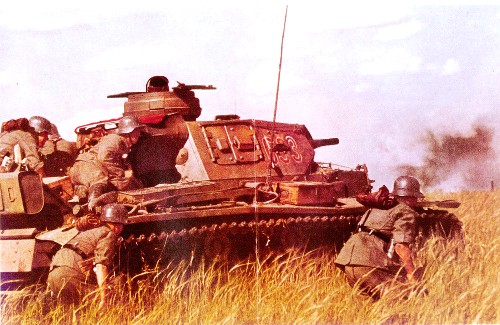

These rules are designed to be simple and fast playing while still retaining historical accuracy and the feel of the period. They are designed for use with small-scale figures, from 6 to 15mm. They are not just “tank rules” but a successful general will need to use combined arms. They are designed with the early war period in mind; and not just for the later battles between Tiger and Stalin tanks.
The “8” in the name comes from my desire to keep the rule size to 8 A4 pages and a data sheet for each nation. With the advent of the HTML version of the rules, I have added photos and more examples and explanations so that they have grown in size but not in complexity. There is an expansion for Panzer 8 adding such things as artillery support, aircraft, hidden setup and engineering.
For 10-15mm figures: All movement and ranges are specified in inches. Each inch represents 33 and one-third metres. The game table is assumed to be about 60 inches long (2000 meters), which is assumed to be maximum visibility for game purposes.
For 6mm figures: You can choose whether movement and ranges are specified in inches or in cm. Using inches you get a better ground scale. Using cm you can play on a smaller table or play larger games on a bigger table.
Each turn represents “the amount of time it takes for one tank to engage another”, which is not a fixed period of time but can be thought to be roughly a minute or five. The time and distance scales are abstracted quite a bit to increase playability, so these rules should not be thought of as a strict simulation in that sense.
|
To play the game you will need a twenty-sided dice and a ruler marked in inches or cm depending on the figure scale used. Two different types of markers are needed; dug-in and suppressed. These do not need to be cardboard squares, for example a dug-in marker can be a U-shaped flocked base that fits neatly round an element base. If expansion rules are being used, additional markers, such as smoke, smoke counters and dismounted elements may be required. |
 |
Model tanks, guns and figures are grouped together on bases to represent units such as a section and are called elements in these rules. Unless otherwise specified below, these should be on bases 30mm x 30 mm (for 12mm figures) and on bases 20mm x 20mm (for 6mm figures).
AFV elements: This includes tanks and self-propelled guns. Each vehicle model represents a single vehicle and should be on bases just big enough to hold it.
One Russian or German infantry element may ride on a tank or assault gun. Other nations may only do so if permitted by the army list or scenario.
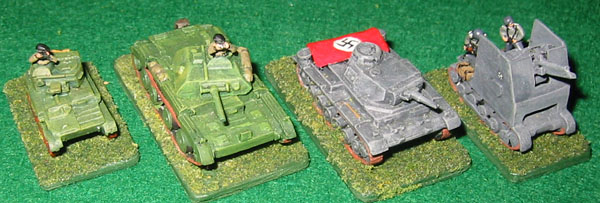
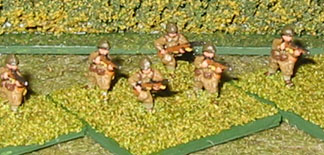
Infantry elements: Four infantry models should be grouped on a base to represent a section (or squad, in American terminology) that was usually around ten to twelve soldiers when the squad was at full strength. Infantry elements normally represent a rifle and LMG armed section, although elements armed with other weapons are possible. An infantry section can include an anti-tank weapon team such as a Panzerfaust, which does not need to be represented by such a model but can be marked on the bottom of the base. If so modelled, this can represent a specialist tank-hunter team such as a Panzerschreck. |
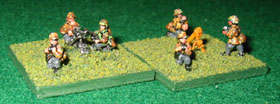
Crew-served weapon elements: A crew-servedweapon and a crew of usually three (two for light mortars and four for heavy artillery) should be grouped on a base representing a single AT-gun or a section of two SFMGs, mortars, or artillery pieces. |
|
Heavier crew-served weapons have a movement of zero, these cannot move without the aid of a transport element. |
Transport elements: A transport model usually represents enough such vehicles to transport two elements or tow a gun element. While normally motorised, they can even be horse-drawn. They should be on bases just big enough to hold them.. These include motorised light trucks, half-tracks or fully tracked transports and horsed wagons or limbers. A large lorry or bus element represents enough such vehicles to transport 4 elements. A small transport such as a jeep or SdKfz 250 can transport one element. Gun-armed transports such as the German 251/10 can only transport 1 unit. When empty and not towing, they are not considered to be combat elements.

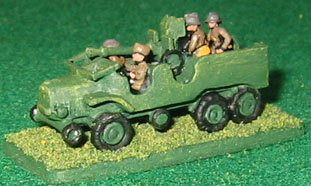
Portee elements: These are weapons carried on transport vehicles. They differ from transported weapons in that they were intended to fire when mounted. Originally these were truck mounted anti-tank guns used by the French and then Britsih in 1940. Unlike transports, they are combat elements. Each vehicle model represents a single vehicle and should be on bases just big enough to hold it. |
Engineer elements: A specialist infantry section equipped for field engineering tasks. An engineer element can include a man-portable flamethrower, which must be represented by such a model. They are normally provided with explosives (giving advantage when assaulting tanks) and equipped with smoke grenades.
|
Commander elements have no combat value but are used to raise the morale of combat elements. They are not considered to be combat elements. |
|
On or adjacent to the base should be placed a counting mechanism; counters with numbers on or 20-sided dice can be use. Every time the army looses a unit the counter is increased by one. The counter gives a quick reference to the number of units lost to enemy action when attempting to remove a suppression marker. Additionally counters for smoke and fire missions can be placed here. The HQ element has no other purpose in the game. They are not considered to be combat elements. |
Each nation is provided with a datasheet containing the stats needed to play a game of Panzer 8. To reduce the number of entries, one datasheet is produce for each campaign.
| Unit Type | The name of the unit. |
| Move | The movement class of the unit. |
| HE/SA | High Explosive/Small Arms. The combat value for attacking "unarmoured" elements: e.g. infantry and soft vehicles. |
| AP | Armour Piercing. The combat value for attacking armoured vehicles: e.g. tanks and armoured cars. |
| Range | The maximum distance the element’s weapons may fire. Some weapons have a minimum range which is expressed as “min-max”. Some elements have different ranges for HE/SA and AP which is expressed as HE(AP). |
| Defence | The element’s protection value when hit by enemy fire. |
| Acc | The weapons accuracy modifier when firing AP. |
| Size | The vehicle size modifier when being fired upon by AP. |
| Notes: | Special rules that apply to the vehicle; for example rear firing main gun or amphibious. |
Some vehicles, like the French Char B1 and Soviet T35, were equipped with more than one main gun. These are indicated on the data sheet by a “secondary gun” entry, with just AP, HE/SA, Max Range and Acc values.
Troops are divided into 3 qualities: Elite, Average and Poor. In some scenarios a single Panzer Ace vehicle may be present. Quality represents training, morale and command-control. These qualities are relative rather than absolute; the majority of troops on the battlefield should be Average.. The following quality modifiers apply to dice rolls where specified:
| Panzer Ace | +2 |
| Elite | +1 |
| Average | No Modifier |
| Poor | -1 |
Examples of troop qualities:
| 1940 • German = Elite • British = Average • French = Average • Italian = Poor |
1944 • German = Elite - Some units are Average (e.g. static divisions) • British = Average - FOO, Paratroops and Commandos are Elite • American = Average - Paratroops and Rangers are Elite • Soviet = Average - Some units Elite (Guards) or Poor |
For movement purposes terrain is split into the following types:
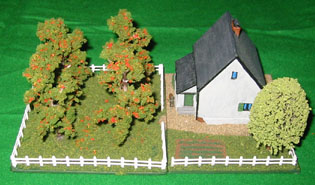
| Good going | Fields, steppes, fords |
| Road | Includes village streets, paths and bridge |
| Rough | Built-up areas, rough, orchards, oasis, dried riverbeds, beaches, hills. |
| Difficult | Ruined BUAs, woods, marshes, steep or rocky hills |
| Extreme | Jungle, forest, and swamps |
| Tracks | Tracks through difficult or extreme terrain. |
| Linear obstacles | Walls, hedges (fences are ignored for game purposes) and streams. |
For protection against fire, terrain is split into the following types:
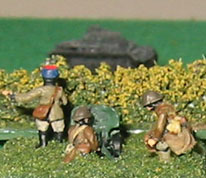
| Open | Fields, steppes, beaches, roads, streams, rivers, sea. |
| Soft cover | Shell holes and wooden buildings. Except against mortar and support fire: Woods, orchards, hedges, walls, fields with high crops, and infantry following directly behind (but not riding on) an AFV. |
| Hard cover | Buildings (even rubble and burned) of stone or brick. Dug-in in fox-holes etc. |
| Fortifications | Concrete bunkers and other permanent fortifications [expansion rule] |
| Hull-down | Hills can have defined crest-lines. Crest lines do not normally provide cover, however a turreted AFV behind and touching a crest-line is considered hull-down. Hull mounted guns may not fire when hull-down. |
When fired upon by a flamethrowers, the target cannot claim protection for cover.
In order to see or shoot at an enemy element, the observing element must have an unobstructed LOS to it. LOS is measured from the centre point of the observing element to the centre point of the target element. If the observing element has a LOS to the target, then the target will automatically have a LOS to the observer.
A LOS is obstructed if it both enters and exits the same terrain feature or if it travels for more than 2 within a single terrain feature. Terrain features that block LOS are buildings, fields with high crops, hills, orchards and woods. A LOS that crosses a crest-line, hedge or wall is blocked unless one of the elements is touching it.
An especially high piece of terrain may be defined before the game as elevated. This can be items such as a hill, a windmill or a church tower. Elements in buildings with elevated terrain must state if they are elevated or not. Changing between elevated and not (or vice versa) counts as movement. An observer in elevated terrain ignores fields with high crops, hedges and walls for LOS purposed.
A tank that is hull-down behind a crest-line has no LOS to the opposite slope.
| First Player: | |
| 1. | Command
Phase a. Elements may test morale in an attempt to remove a suppression marker. b. Elements may attempt to communicate. [expansion rule] |
| 2. | Fire Phase a. Lay smoke. [expansion rule] b. Support fire and Air Support. [expansion rule] c. Speculative fire. [expansion rule] d. Direct fire. HE/SA, AP, and Tank hunting. |
| 3. | Close
Combat Phase a. Resolve hand-to-hand combat and tank overruns. b. Advance after combat. |
| 4. | Movement
Phase a. Friendly elements may move. b. Non-combat elements are overrun. |
| Second Player: | |
| 5-8. | Repeat phases 1-4. |
An element may attempt to remove a suppression marker by testing morale. Roll 1d20, apply any modifiers and score 12 or more to succeed. An unmodified roll of 1 causes the element to rout and be removed from play.
| +1 | Friendly commander within 4 |
| +2 | For each scenario designated objective captured |
| + or - | Troop Quality |
| -1 | For every three friendly elements removed from play by enemy action |
| -1 | Element within 4 of a table edge other than its own base edge |
| -3 | Unsupported. AFVs are supported if they have AFVs within 4 or radio-equipped of same type within 8. Other troops are supported if they have a friendly combat element within 4. Supporting units may not be suppressed. |
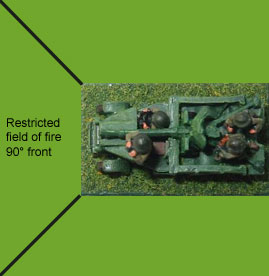
Elements can only shoot at targets in their field of fire to which they have a LOS. Most units have a have a 360° field of fire. Crew-served weapons, turret-less AFVs and some other elements have a restricted 90° field of fire as indicated on their data sheet. Crew-served weapons and some other elements, as indicated on their data sheet, cannot both fire and move.
Direct fire (HE/SA, AP, Tank hunting) is considered to take place at any time during the enemy element’s movement and if an element is hit it might be necessary to move it back to the place where it was fired upon.
Infantry riding in a vehicle may not be targeted, although they may be shot at when mounting or dismounting; instead it is the vehicle in which they are riding that is targetted. Tank riders may be targeted even when mounted. Elements in a hand-to-hand combat may not be targeted.
All infantry and engineer elements transported in an APC, and one such element in soft transport may fire. When mounted, flamethrowers and Crew Served Weapons (unless portee) may not fire.
An element may not shoot through a friendly element, except when in an elevated position or mortar armed in which case the friendly element must be nearer the firer than the target. An element firing SA must have a one base with wide clear path to the target. An element firing SA may not fire through enemy infantry or crew served weapons which it could shoot at except to hit a vehicle or a target moving in the open.
An element may only fire once each player turn, with the exception that tanks with multiple guns may also fire their secondary guns as specified on the unit data charts.
Forward Observers on foot may not be targeted at ranges greater than 4.
Suppressed elements have their range limited to 4, have a restricted 90° field of fire and may not fire if contacted.
AP is used to fire at armoured targets.
To Hit:
Roll 1d20. If result is 12 or more plus all modifiers,
it’s a hit. An unmodified 20 is always a hit.
| +1 | Target within range 4: ignored by firer with a range of only 4 or when suppressed |
| -1 | Target over half range |
| -2 | Target is in soft cover |
| -4 | Target is in hard cover, hull-down or behind smoke |
| -1 | Firer within 4 of a table edge other than its own base edge |
| + or - | Firer's accuracy |
| + or - | Target size |
| + or - | Firer's Troop Quality |
 To Penetrate:
To Penetrate:
| Odds: AP to Armour | ||||||||
| Dice roll | 1:4 | 1:3 | 1:2 | 2:3 | 1:1 | 3:2 | 2:1 | 3:1 |
| 1-7 | - | - | - | - | - | - | S | K |
| 8-10 | - | - | - | - | - | S | K | K |
| 11-14 | - | - | - | S | S | S | K | K |
| 15-17 | - | - | - | S | K | K | K | K |
| 18-20 | - | - | S | K | K | K | K | K |
Elements with an
AP value of *
Mortars use the 1:2 column when attacking vehicles with an
armour
value of 2 or
less or when attacking open topped vehicles or armoured cars.
SFMGs use the 1:2 column when attacking vehicles with an
armour
value of 2 or
less.
Mortars and SFMGs cannot
damage other vehicles.
Flamethrowers automatically hit and use the 3:2 column to resolve
damage.
Troop modifiers can apply but not columns shifts.
HE/SA is used to fire at unarmoured targets such as infantry, guns and soft vehicles. Roll 1d20, add the firer’s HE/SA value subtract the target’s defence value and apply any modifiers.
| +1 | Target within range 4: ignored by firer with a range of 4 or when suppressed |
| -2 | Target is in soft cover |
| -4 | Target is in hard cover or behind smoke |
| -1 | Firer within 4 of a table edge other than its own base edge |
| + or - | Firer's Troop Quality |
| +2 | Cavalry that initiate close combat against elements in open, fields or dug-in. [expansion rule] |
| Dice Roll... | Result... |
| -11 | No Effect |
| 12-13 | F - Fall-back |
| 14-17 | S - Suppressed |
| 18+ | K - Knocked out |
An infantry section (including bicycle and engineers but not crew served weapons, motorcycle or cavalry) may attempt to close assault an AFV instead of shooting. In order to do so the infantry may not be suppressed and must be within range 2 of the AFV. Except when hunting suppressed AFVs, the infantry and/or the AFV must be in hard cover or soft cover other than fields.
If the AFV has friendly infantry in base contact, these may fire close defence first. If a result is obtained then the tank hunting automatically fails.
If the AFV is open-topped or the attacker is an engineer section then the AFV is attacked using the anti-tank damage table with odds of 3:2, otherwise with odds of 1:1. Quality modifiers apply.
If the infantry fail to obtain a result and if the AFV is MG equipped, then it may immediately fire close defence using HE/SA with an attack value of 4.
F = Elements in fortifications, dug in or under support or mortar fire and crew-served weapons ignore this result if suppressed, otherwise treating it as an ’S’. Other elements must immediately make two successive fall-back moves.
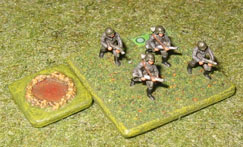 S
=
Element becomes
suppressed; this being indicated by placing a suppressed marker next to
the element. An already suppressed element treats this result as a
‘K’. The following applies to suppressed elements.
S
=
Element becomes
suppressed; this being indicated by placing a suppressed marker next to
the element. An already suppressed element treats this result as a
‘K’. The following applies to suppressed elements.
K = The element plays no further part in this battle and is removed from play. Actually the unit may not have been killed, but is out of action for game purposes; for example it might be a tank with its armament disabled or which cannot move or a unit that totally looses its nerve and flees the field. If there are multiple elements riding in a transport, a K result will cause only one transported element to be knocked out; select randomly. The transport and remaining elements will be suppressed.
Passengers riding in a transport, tank riders and limbered guns suffer the same fate as the vehicle. Passengers in a soft vehicle or on a tank must, and in an APC may, dismount on becoming suppressed. Tank riders will automatically dismount if the vehicle is hit by AP without having damaged the vehicle.
Close combat is used to resolve hand-to-hand combat and tank overruns for adjacent enemy elements. However not all elements will resolve close combat just because they are adjacent; for example trucks.
If two non-vehicle elements are in base contact with each other, or separated by a linear obstacle or fortification, then they are in hand-to-hand combat.
Hand-to-hand combat is resolved using the HE/SA table. Combat is considered to be simultaneous. Modifiers for cover are ignored if all elements are in the same type of cover.
Crew served weapons and Forward Observers have a HE/SA value of 4 in close combat. Crew served weapon, Forward Observers and Commander elements may not move so as to initiate hand-to-hand combat.
A player may move multiple units into contact with a single opponent in which case he may roll for each of the units. Should his opponent obtain a result it is only applied to one unit at the owner’s choice.
Elements in hand-to-hand combat may not be voluntarily targeted nor may they fire. However this does not stop the charged unit, unless suppressed, from firing just before it is contacted.
Tank overrun is resolved using the HE/SA table with an attack value of 8. It occurs when an unsuppressed tank (but not other AFVs), is in front base contact with, or separated by a linear obstacle from, an element other than a vehicle (including motorcycles). Overrun may only be attempted in open terrain or in fields although even dug-in troops may be overrun.
If the tank does not get a result, an unsuppressed unit (other than crew served weapon) may close assault the tank using the anti-tank damage table with odds of 1:2. Quality modifiers apply.
If the attacking unit survives and is unsuppressed it will attempt to advance so as to occupy the defenders position. If the defending unit is still in position it must retreat 2 base depths unless dug-in or in fortifications.
Each element may move up to the distance allowed for its movement rate as indicated on its entry in the data sheets. Movement rate for the slowest terrain is used. Movement can be split into two halves to better calculate movement through different terrain types.
Elements with movement 0 may rotate in place but can otherwise only move when limbered or embarked. Other elements move as follows:
| Movement class... | Distance |
| Cmd (Command), Mech (Mechanised incl. cavalry) | 8 |
| Inf (Infantry), S (Slow AFV), Wh (Wheeled), HD (Horse-drawn) | 4 |
| CSW (Crew Served Weapon) | 1 |
| Movement class... | Road | Open | Rough | Difficult | Extreme | Track |
| Cmd (Command) | 8 | 8 | 8 | 8 | 0 | 8 |
| Mech (Mechanised incl.Cavalry) | 8 | 8 | 4 | 4 | 0 | 2 |
| Inf (Infantry) | 4 | 4 | 4 | 4 | 2 | 2 |
| S (Slow AFV) | 4 | 4 | 4 | 4 | 0 | 2 |
| Wh (Wheeled) | 10 | 4 | 2 | 0 | 0 | 2 |
| HD (Horse-drawn) | 4 | 4 | 2 | 0 | 0 | 2 |
| CSW (Crew Served Weapon) | 1 | 1 | 1 | 1 | 0 | 1 |
Linear obstacle: To cross a linear obstacle takes ½ movement.
A vehicle that moves outside its front facing (i.e. behind a line extending along its front base edge), as per the start of its move, has its move reduced by 50%. Ignored by vehicles with a rear driver.
Crew-served weapons take one entire turn to limber, unlimber, embark or disembark. In order to limber or embark they must start adjacent to their tractor and may not fire in the same turn. When unlimbering or disembarking they are placed anywhere adjacent to their tractor. When limbered or embarked they may not fire.
Man portable crew-served weapons (SFMG, light and medium mortars) may break down for movement, taking an entire turn to do so. Once broken down they move as infantry. It takes another entire turn to setup for firing. When broken-down they may not fire. (Note: British and Japanese light mortars move as infantry and as such ignore this rules.)
Infantry that start the turn adjacent to a transport or tank may mount without movement penalty. They may dismount at the end of the vehicles movement, being placed adjacent to the vehicle, but the infantry may not move further. Infantry may not mount and dismount in the same turn.
Units may move through friendly units unless on tracks, bridges or roads. They may not pass though enemy.
A fall-back is movement backwards: directly away from the enemy or directly towards its own home board edge. Vehicles can do this either by starting their movement with a 180° turn or by reversing. Fall-back is the only movement allowed to suppressed elements or transports without any embarked element.
Troops that enter the board on a road have their movement increased by 2 until such time as they leave the road or are fired upon. Crew-served weapons must enter the board limbered, embarked or broken down for movement.
Non-combat elements (Commanders, FOO, empty Transport, etc) that are in base contact with enemy elements at the end of the movement phase are removed. A Commander should be replaced by removing a combat element in the commander's chain-of-command and placing the commander in its position. If no combat element exists that isn’t in contact with the enemy then the commander isn’t replaced.
Inspiration and ideas have been borrowed from, among others, the Tank Battles in Miniature series by Donald Featherstone and Bruce Quarrie and Panzer III by David Ferris. These rules are copyright 2004-2008 Keith Barker. They may be freely copied for non-commercial use proving that this copyright remains unchanged.